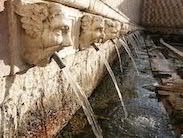Speaker
Description
The discovery of a diffuse flux of astrophysical neutrinos by IceCube has opened up new possibilities for the search of cosmic-ray sources. The sources that accelerate cosmic rays to extreme energies are most-likely also high-energy neutrino emitters. To find such sources one can look for correlations in arrival directions between astrophysical neutrinos and ultra-high-energy cosmic rays (UHECRs). However, UHECRs are deflected by magnetic fields on their way from their sources to Earth, and are subject to energy-loss processes (resulting in a maximum distance from which they can arrive). We investigate how these effects influence the expected probability to find correlations between high-energy neutrinos and UHECRs, depending on the evolution with redshift of the sources. The possibility to observe correlations between UHECRs and neutrinos is already strongly constrained by the absence of neutrino multiplets in the IceCube measurements. However, if connections between neutrinos and cosmic rays are measured, it would give a precise indication for the local density of the emitters.

